You might remember that, a couple of weeks ago, TAG playtested Decode Global‘s Get Water! at one our our 5a7s. TAG and Hexagram have had the pleasure of hosting Decode Global at Concordia for some time now, and we’re very happy to see how well Get Water! is doing. The project, for example, won the Create UNAOC Award for 2012. Tomorrow, on World Water Day, Get Water! is slated for launch and here’s a little bit about what to expect. I also recommend watching the trailer.
The heroine of Get Water! is Maya, a little girl from India who is pulled out of school to fetch water after the pump breaks in her neighbourhood. As I mentioned during my writeup for the playtest: A few of the dangers that she has to avoid: peacocks, who will scare her into dropping the water, turtles that she might trip over, errant footballs that might knock over her jug, and of course, the very real threat of contaminated water. She is armed with boomerangs and other unlockables that will send her enemies running or improve her ability to get water.
So, when I last played Get Water!, it was on an iPad. I played the current build on my little old iPhone, and I have to say that that switch made a pretty big difference for me. Playing on the iPhone was, for me, a lot more difficult because my drawings had to be much more precise – I found that I was doing the same kind of drawing that I did on the iPad, but not getting the same results (probably because the displacement of a few millimetres matters a lot more on the smaller interface). I also found drawing Maya’s trajectory a lot easier on the iPad because I could draw shorter parts of her path and wait to see what was coming (a technique that didn’t really work on the iPhone’s smaller screen). So, if you have the choice, I’d really recommend getting it for the iPad. Otherwise, I got used to playing on the iPhone after a while.
One of the highlights of the game is that it’s a story-driven endless runner, which is not something that I’ve seen too often. During the playtest, not all of the cut scenes when the player unlocks parts of Maya’s story were implemented yet, so it was with great pleasure that I watched the new cut scenes, which allow the player to get to know Maya and her environment and see how the consumable items in the game were actually born of Maya’s innovative thinking about the world that she lives in – such as finding a new way to get around the turtles after watching her friend cross the water on some rocks, or using the rubber from balloons to block up the holes in her water jug. The scarcity of water has forced Maya out of school, and the game makes it clear that she is an obviously intelligent young woman who deserves an education.
I still love the idea that it is the cumulative effect of the player’s efforts that leads to rewards and changes in the game – an idea that is reinforced by the way that levelling up works in the game by adding up the percentage of progress from each individual run. Everything is just a drop in the bucket, but those drops in the bucket add up! So, as a message for social change, that kind of thinking is definitely appreciated. If we took the same approach to social change that we do to crowdfunding and kickstarting, we’d start to see some definite results come out of those drops in the bucket.
What I enjoyed in this final version was that the player gets to hear Maya’s voice – it’s a small change, but I felt a lot more connected to her because of it. (I’m not completely sure if this was in the play test version or not, just because the room was full of people and the sound may have been turned down – but even if it’s not new, it’s new to me!)
Overall, this is a game with a great message and a fun interface that has, to date, kept me busy for about four hours. Water is a universal need, which makes Get Water! a very relatable game that’s also just a lot of fun to play.
You can visit Decode Global’s website or follow them on Twitter (@decodeglobal). Get Water! launches tomorrow for iOS.

